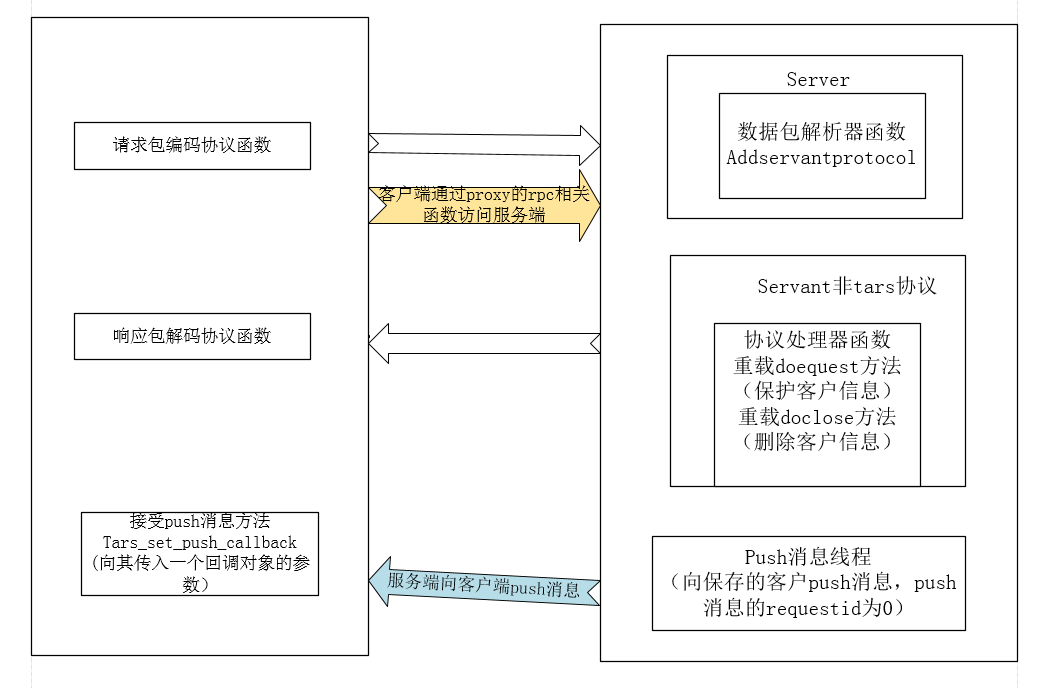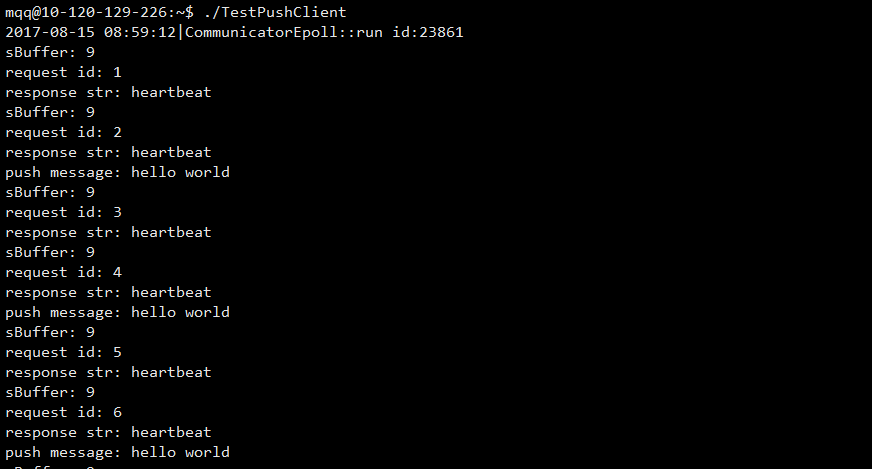Tars 的 push 功能
目录
- [1.环境和背景]
- [2.push 模式的流程图]
- [3.服务端功能的实现]
- [4.客户端功能的实现]
- [5.测试结果]
环境和背景
但是在实际的应用场景中,需要在 TARS 服务框架中支持其他服务端到客户端的 push 模式
具体程序示例,参见 examples/PushDemo/.
push 模式的流程图
下面是 push 模式的示意图

- 黑色线代表了数据流向:数据(客户端)-〉请求包的编码器(客户端)-〉协议解析器(服务端)-〉doRequest 协议处理器(服务端)-〉生成返回数据(服务端)-〉响应包的解码器(客户端)-〉响应数据(客户端)
- 黄色线代表客户端访问服务端
- 蓝色线代表服务端向客户端 push 消息
- 其中请求包的编码器(客户端)负责对客户端发送的数据进行打包编码,协议解析器(服务端)负责对收到的数据进行解包并交给*
- 协议处理器(服务端)去处理并生成返回数据,而响应包的解码器(客户端)负责对返回的数据进行解码。
Tars 中实现服务端到客户端的 push 模式:
- 对于服务端,首先服务端需要按照开发第三方协议的模式(即非 tars 协议),实现协议包的解析器,并将其加载到服务中,同时需要建立一个非 TARS 框架的服务对象,该类继续继承 TARS 框架的 Servant 类,通过重载 Servant 类中的 doRequest 方法建立客户端和服务端之间的协议处理器,同时在该方法中保存连接到服务端的客户信息,以便服务端向客户端 push 消息,另外需要重载 Servant 类中的 doClose 方法,在服务器得知客户关闭连接后,释放 doRequest 方法中保存的客户信息,这样就可以不需要对该客户进行 push 消息。另外,服务端需要建立一个专门用于向客户端 push 消息的线程。
- 对应客户端,首先要按照第三方协议的模式,实现协议包的编解码函数,并将其设置到相应的 ServantProxy 代理的协议解析器中,通过 ServantProxy 类 tars_set_protocol 方法实现;然后需要自定义一个回调类,该类继承 ServantProxyCallback 类,(因为服务端 push 消息给客户端时,客户端收到消息是异步的,所以客户端对消息的处理以异步方法进行),同时需要重载其中的 onDispatch 方法,在该方法中,对客户端和服务端之间定义的协议进行解析处理;最后需要 new 一个上面自定义的回调类,然后将其作为参数传入到 ServantProxy 的 tars_set_push_callback 方法中。另外,客户端需要定期的发送消息给服务端(相当于心跳包),以便告诉服务端,客户端是存活的(因为服务端在一定时间内没收到来自客户端的消息,会自动关闭其之间的连接)。 另外,在服务端与客户端 push 模式交互之前,客户端要访问服务,需要通过调用 ServantProxy 类的 rpc 相关函数。
服务端功能的实现
服务端实现概述
首先我们按照第三方协议代码部署一个 TestPushServant 服务 如下图所示在管理平台部署一个服务端

参考 tars 支持第三方协议
- 其中 TestPushServer 类的 initialize( ) 加载服务对象 TestPushServantImp,并设置第三方协议解析器 parse,这里解析器不做任何处理,把接收到的数据包原封不动的传给服务对象去处理(但通常情况下,要对数据进行解析后才交给服务对象去处理),
- 而 TestPushServantImp 重载继承自 Servant 类的 doRequest 方法,该方法为第三方服务的协议处理器,该处理器负责处理协议解析器传送给其的数据,并负责生成返回给客户端的 response(本服务为 echo 服务,因此直接让 response 等于收到的数据包),同时保存客户的信息状态,以便让 pushThread 线程对客户进行 push 消息;
- 另外 TestPushServantImp 重载继承自 Servant 类的 doClose 方法,用于客户关闭连接或者连接超时后清除保存相关的客户信息。
服务端代码实现
TestPushServantImp.h
#ifndef _TestPushServantImp_H_
#define _TestPushServantImp_H_
#include "servant/Application.h"
//#include "TestPushServant.h"
/**
*
*
*/
class TestPushServantImp : public tars::Servant
{
public:
/**
*
*/
virtual ~TestPushServantImp() {}
/**
*
*/
virtual void initialize();
/**
*
*/
virtual void destroy();
/**
*
*/
virtual int test(tars::TarsCurrentPtr current) { return 0;};
//重载Servant的doRequest方法
int doRequest(tars::TarsCurrentPtr current, vector<char>& response);
//重载Servant的doClose方法
int doClose(tars::TarsCurrentPtr current);
};
/////////////////////////////////////////////////////
#endif
TestPushServantImp.cpp
#include "TestPushServantImp.h"
#include "servant/Application.h"
#include "TestPushThread.h"
using namespace std;
//////////////////////////////////////////////////////
void TestPushServantImp::initialize()
{
//initialize servant here:
//...
}
//////////////////////////////////////////////////////
void TestPushServantImp::destroy()
{
//destroy servant here:
//...
}
int TestPushServantImp::doRequest(tars::TarsCurrentPtr current, vector<char>& response)
{
//保存客户端的信息,以便对客户端进行push消息
(PushUser::mapMutex).lock();
map<string, TarsCurrentPtr>::iterator it = PushUser::pushUser.find(current->getIp());
if(it == PushUser::pushUser.end())
{
PushUser::pushUser.insert(map<string, TarsCurrentPtr>::value_type(current->getIp(), current));
LOG->debug() << "connect ip: " << current->getIp() << endl;
}
(PushUser::mapMutex).unlock();
//返回给客户端它自己请求的数据包,即原包返回
const vector<char>& request = current->getRequestBuffer();
response = request;
return 0;
}
//客户端关闭到服务端的连接,或者服务端发现客户端长时间未发送包过来,然后超过60s就关闭连接
//调用的方法
int TestPushServantImp::doClose(TarsCurrentPtr current)
{
(PushUser::mapMutex).lock();
map<string, TarsCurrentPtr>::iterator it = PushUser::pushUser.find(current->getIp());
if(it != PushUser::pushUser.end())
{
PushUser::pushUser.erase(it);
LOG->debug() << "close ip: " << current->getIp() << endl;
}
(PushUser::mapMutex).unlock();
return 0;
}
TestPushThread.h
#ifndef __TEST_PUSH_THREAD_H
#define __TEST_PUSH_THREAD_H
#include "servant/Application.h"
class PushUser
{
public:
static map<string, TarsCurrentPtr> pushUser;
static TC_ThreadMutex mapMutex;
};
class PushInfoThread : public TC_Thread, public TC_ThreadLock
{
public:
PushInfoThread():_bTerminate(false),_tLastPushTime(0),_tInterval(10),_iId(0){}
virtual void run();
void terminate();
void setPushInfo(const string &sInfo);
private:
bool _bTerminate;
time_t _tLastPushTime;
time_t _tInterval;
unsigned int _iId;
string _sPushInfo;
};
#endif
TestPushThread.cpp
#include "TestPushThread.h"
#include <arpa/inet.h>
map<string, TarsCurrentPtr> PushUser::pushUser;
TC_ThreadMutex PushUser::mapMutex;
void PushInfoThread::terminate(void)
{
_bTerminate = true;
{
tars::TC_ThreadLock::Lock sync(*this);
notifyAll();
}
}
void PushInfoThread::setPushInfo(const string &sInfo)
{
unsigned int iBuffLength = htonl(sInfo.size()+8);
unsigned char * pBuff = (unsigned char*)(&iBuffLength);
_sPushInfo = "";
for (int i = 0; i<4; ++i)
{
_sPushInfo += *pBuff++;
}
unsigned int iRequestId = htonl(_iId);
unsigned char * pRequestId = (unsigned char*)(&iRequestId);
for (int i = 0; i<4; ++i)
{
_sPushInfo += *pRequestId++;
}
_sPushInfo += sInfo;
}
//定期向客户push消息
void PushInfoThread::run(void)
{
time_t iNow;
setPushInfo("hello world");
while (!_bTerminate)
{
iNow = TC_TimeProvider::getInstance()->getNow();
if(iNow - _tLastPushTime > _tInterval)
{
_tLastPushTime = iNow;
(PushUser::mapMutex).lock();
for(map<string, TarsCurrentPtr>::iterator it = (PushUser::pushUser).begin(); it != (PushUser::pushUser).end(); ++it)
{
(it->second)->sendResponse(_sPushInfo.c_str(), _sPushInfo.size());
LOG->debug() << "sendResponse: " << _sPushInfo.size() <<endl;
}
(PushUser::mapMutex).unlock();
}
{
TC_ThreadLock::Lock sync(*this);
timedWait(1000);
}
}
}
TestPushServer.h
#ifndef _TestPushServer_H_
#define _TestPushServer_H_
#include <iostream>
#include "servant/Application.h"
#include "TestPushThread.h"
using namespace tars;
/**
*
**/
class TestPushServer : public Application
{
public:
/**
*
**/
virtual ~TestPushServer() {};
/**
*
**/
virtual void initialize();
/**
*
**/
virtual void destroyApp();
private:
//用于push消息的线程
PushInfoThread pushThread;
};
extern TestPushServer g_app;
////////////////////////////////////////////
#endif
TestPushServer.cpp
#include "TestPushServer.h"
#include "TestPushServantImp.h"
using namespace std;
TestPushServer g_app;
/////////////////////////////////////////////////////////////////
static TC_NetWorkBuffer::PACKET_TYPE parse(TC_NetWorkBuffer &in, vector<char> &out)
{
size_t len = sizeof(tars::Int32);
if (in.getBufferLength() < len)
{
return TC_NetWorkBuffer::PACKET_LESS;
}
string header;
in.getHeader(len, header);
assert(header.size() == len);
tars::Int32 iHeaderLen = 0;
::memcpy(&iHeaderLen, header.c_str(), sizeof(tars::Int32));
iHeaderLen = ntohl(iHeaderLen);
if (iHeaderLen > 100000 || iHeaderLen < sizeof(unsigned int))
{
throw TarsDecodeException("packet length too long or too short,len:" + TC_Common::tostr(iHeaderLen));
}
if (in.getBufferLength() < (uint32_t)iHeaderLen)
{
return TC_NetWorkBuffer::PACKET_LESS;
}
in.getHeader(iHeaderLen, out);
in.moveHeader(iHeaderLen);
return TC_NetWorkBuffer::PACKET_FULL;
}
void
TestPushServer::initialize()
{
//initialize application here:
//...
addServant<TestPushServantImp>(ServerConfig::Application + "." + ServerConfig::ServerName + ".TestPushServantObj");
addServantProtocol("Test.TestPushServer.TestPushServantObj", parse);
pushThread.start();
}
/////////////////////////////////////////////////////////////////
void
TestPushServer::destroyApp()
{
//destroy application here:
//...
pushThread.terminate();
pushThread.getThreadControl().join();
}
/////////////////////////////////////////////////////////////////
int
main(int argc, char* argv[])
{
try
{
g_app.main(argc, argv);
g_app.waitForShutdown();
}
catch (std::exception& e)
{
cerr << "std::exception:" << e.what() << std::endl;
}
catch (...)
{
cerr << "unknown exception." << std::endl;
}
return -1;
}
/////////////////////////////////////////////////////////////////
客户端实现
客户端实现概述
本节介绍客户端通过 proxy 的方式来访问服务端,具体步骤如下:
- 客户端首先建立通信器(Communicator _comm),并通过该通信器获取 proxy,代码格式如下:
string sObjName = "Test.TestPushServer.TestPushServantObj";
string sObjHost = "tcp -h 10.120.129.226 -t 60000 -p 10099";
_prx = _comm.stringToProxy<ServantPrx>(sObjName+"@"+sObjHost);
- 编写 proxy 的请求包的编码器和响应包的解码器并设置,代码格式如下:
请求包的编码器格式:
static vector<char> pushRequest(RequestPacket& request, Transceiver *)
响应包的解码器格式:
static TC_NetWorkBuffer::PACKET_TYPE pushResponse(TC_NetWorkBuffer &in, ResponsePacket& rsp)
proxy设置代码为:
ProxyProtocol prot;
prot.requestFunc = pushRequest;
prot.responseFunc = pushResponse ;
_prx->tars_set_protocol(prot);
-
同步方法或者异步方法访问服务端
- 同步方法通过调用 proxy 的 rpc_call 方法访问服务
virtual void rpc_call(uint32_t requestId, const string& sFuncName,const char* buff, uint32_t len, ResponsePacket& rsp);其中参数 requestId 需要在一个 object 内唯一,可以通过 proxy 的 uint32_t tars_gen_requestid()接口获得一个该 object 内唯一的 id。sFuncName 主要用于框架层对接口调用的统计分析,可以缺省为”“。buff 为要发送的内容,len 为 buff 的长度。rsp 则为本次调用得到的 ResponsePacket 包。
-
异步方法通过调用 proxy 的 rpc_call_asyc 方法访问服务
virtual void rpc_call_async(uint32_t requestId, const string& sFuncName, const char* buff, uint32_t len, const ServantProxyCallbackPtr& callback);其中参数 requestId 需要在一个 object 内唯一,可以通过 proxy 的 uint32_t tars_gen_requestid()接口获得一个该 object 内唯一的 id。sFuncName 为回调对象响应后调用的函数名。buff 为要发送的内容,len 为 buff 的长度。callback 则为本次调用返回结果后,即服务端返回处理结果后,此回调对象会被响应。
-
设置接受服务端的 push 消息方法:
TestPushCallBackPtr cbPush = new TestPushCallBack();
_prx->tars_set_push_callback(cbPush);
客户端具体实现
main.cpp
#include "servant/Application.h"
#include "TestRecvThread.h"
#include <iostream>
using namespace std;
using namespace tars;
int main(int argc,char**argv)
{
try
{
RecvThread thread;
thread.start();
int c;
while((c = getchar()) != 'q');
thread.terminate();
thread.getThreadControl().join();
}
catch(std::exception&e)
{
cerr<<"std::exception:"<<e.what()<<endl;
}
catch(...)
{
cerr<<"unknown exception"<<endl;
}
return 0;
}
TestRecvThread.h
#ifndef __TEST_RECV_THREAD_H
#define __TEST_RECV_THREAD_H
#include "servant/Application.h"
class TestPushCallBack : public ServantProxyCallback
{
public:
virtual int onDispatch(ReqMessagePtr msg);
};
typedef tars::TC_AutoPtr<TestPushCallBack> TestPushCallBackPtr;
class RecvThread : public TC_Thread, public TC_ThreadLock
{
public:
RecvThread();
virtual void run();
void terminate();
private:
bool _bTerminate;
Communicator _comm;
ServantPrx _prx;
};
#endif
TestRecvThread.cpp
#include "TestRecvThread.h"
#include <iostream>
#include <arpa/inet.h>
/*
响应包解码函数,根据特定格式解码从服务端收到的数据,解析为ResponsePacket
*/
static TC_NetWorkBuffer::PACKET_TYPE pushResponse(TC_NetWorkBuffer &in, ResponsePacket& rsp)
{
size_t len = sizeof(tars::Int32);
if (in.getBufferLength() < len)
{
return TC_NetWorkBuffer::PACKET_LESS;
}
string header;
in.getHeader(len, header);
assert(header.size() == len);
tars::Int32 iHeaderLen = 0;
::memcpy(&iHeaderLen, header.c_str(), sizeof(tars::Int32));
iHeaderLen = ntohl(iHeaderLen);
//做一下保护,长度大于M
if (iHeaderLen > 100000 || iHeaderLen < (int)sizeof(unsigned int))
{
throw TarsDecodeException("packet length too long or too short,len:" + TC_Common::tostr(iHeaderLen));
}
//包没有接收全
if (in.getBufferLength() < (uint32_t)iHeaderLen)
{
return TC_NetWorkBuffer::PACKET_LESS;
}
in.moveHeader(sizeof(iHeaderLen));
tars::Int32 iRequestId = 0;
string sRequestId;
in.getHeader(sizeof(iRequestId), sRequestId);
in.moveHeader(sizeof(iRequestId));
rsp.iRequestId = ntohl(*((unsigned int *)(sRequestId.c_str())));
len = iHeaderLen - sizeof(iHeaderLen) - sizeof(iRequestId);
in.getHeader(len, rsp.sBuffer);
in.moveHeader(len);
return TC_NetWorkBuffer::PACKET_FULL;
}
/*
请求包编码函数,本函数的打包格式为
整个包长度(4字节)+iRequestId(4字节)+包内容
*/
static vector<char> pushRequest(RequestPacket& request, Transceiver *)
{
unsigned int net_bufflength = htonl(request.sBuffer.size()+8);
unsigned char * bufflengthptr = (unsigned char*)(&net_bufflength);
vector<char> buffer;
buffer.resize(request.sBuffer.size()+8);
memcpy(buffer.data(), bufflengthptr, sizeof(unsigned int));
unsigned int netrequestId = htonl(request.iRequestId);
unsigned char * netrequestIdptr = (unsigned char*)(&netrequestId);
memcpy(buffer.data() + sizeof(unsigned int), netrequestIdptr, sizeof(unsigned int));
memcpy(buffer.data() + sizeof(unsigned int) * 2, request.sBuffer.data(), request.sBuffer.size());
return buffer;
// sbuff->addBuffer(buffer);
}
static void printResult(int iRequestId, const string &sResponseStr)
{
cout << "request id: " << iRequestId << ", response str: " << sResponseStr << endl;
}
static void printPushInfo(const string &sResponseStr)
{
cout << "push message: " << sResponseStr << endl;
}
int TestPushCallBack::onDispatch(ReqMessagePtr msg)
{
if(msg->request.sFuncName == "printResult")
{
string sRet;
sRet.assign(&(msg->response->sBuffer[0]), msg->response->sBuffer.size());
printResult(msg->request.iRequestId, sRet);
return 0;
}
else if(msg->response->iRequestId == 0)
{
string sRet;
sRet.assign(&(msg->response->sBuffer[0]), msg->response->sBuffer.size());
printPushInfo(sRet);
return 0;
}
else
{
cout << "no match func!" <<endl;
}
return -3;
}
RecvThread::RecvThread():_bTerminate(false)
{
string sObjName = "Test.TestPushServer.TestPushServantObj";
string sObjHost = "tcp -h 10.120.129.226 -t 60000 -p 10099";
_prx = _comm.stringToProxy<ServantPrx>(sObjName+"@"+sObjHost);
ProxyProtocol prot;
prot.requestFunc = pushRequest;
prot.responseFunc = pushResponse;
_prx->tars_set_protocol(prot);
}
void RecvThread::terminate()
{
_bTerminate = true;
{
tars::TC_ThreadLock::Lock sync(*this);
notifyAll();
}
}
void RecvThread::run(void)
{
TestPushCallBackPtr cbPush = new TestPushCallBack();
_prx->tars_set_push_callback(cbPush);
string buf("heartbeat");
while(!_bTerminate)
{
{
try
{
TestPushCallBackPtr cb = new TestPushCallBack();
_prx->rpc_call_async(_prx->tars_gen_requestid(), "printResult", buf.c_str(), buf.length(), cb);
}
catch(TarsException& e)
{
cout << "TarsException: " << e.what() << endl;
}
catch(...)
{
cout << "unknown exception" << endl;
}
}
{
TC_ThreadLock::Lock sync(*this);
timedWait(5000);
}
}
}
客户端测试结果
如果 push 成功,结果如下
